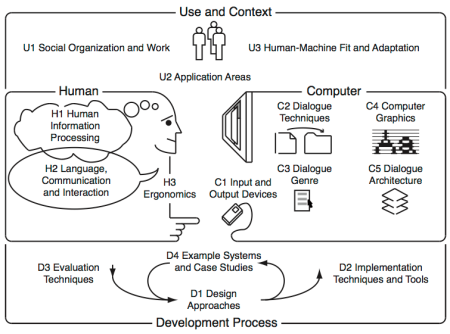Goal and Outcomes.
This course introduces students to the field of human-computer interaction.
Introduction
The body of knowledge of Human-Computer Interaction can be perceived as resulting from the following five interrelated aspects, depicted in the diagram bellow:
(N) the nature of human-computer interaction;
(U) the use and context of computers;
(H) human characteristics;
(C) computer system and interface architecture; and
(D) the development process.
This course touches the (N) aspect but mainly targets the (H) aspects illustrated in the diagram above. It comprises seven modules:
Visibility, Affordances, Mapping, Constraints, Conceptual models
Seven stages of action, Types of knowledge
Feedback, Errors, Forcing Functions, Gestalt laws, Responsiveness
The Human Processor Model, Fitts Law
Interface Efficiency, KLM, GOMS
State transition diagrams, Petri nets
History and vision
After successfully attending this course, students will know how user interfaces have developed over the past decades, and what constants of human performance need to be considered when designing user interfaces.
Further details are available including…
- The pedagogical script;
- The technical script;
- The assessment criteria; and
- The bibliography.
Foundations of Human-Computer Interaction


0 commenti :
Posta un commento